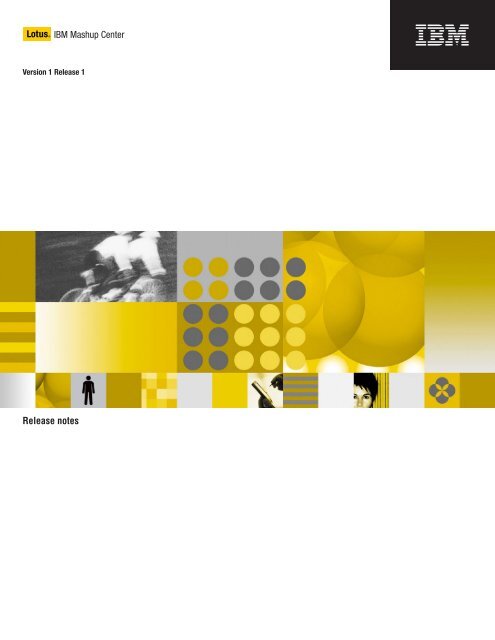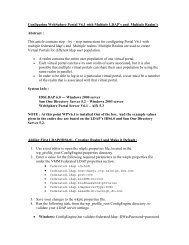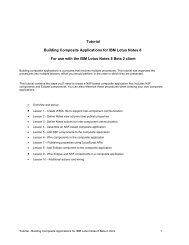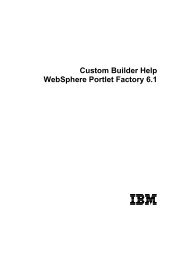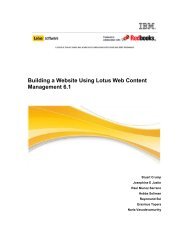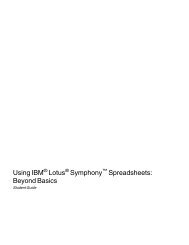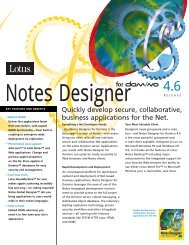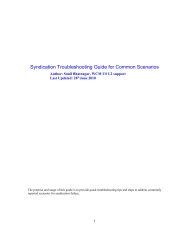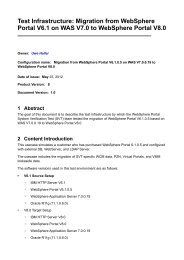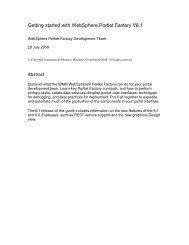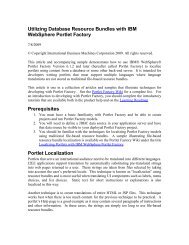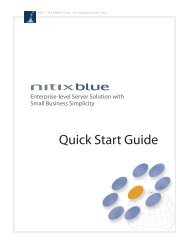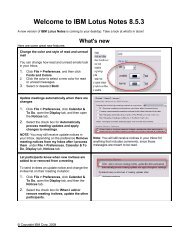Create successful ePaper yourself
Turn your PDF publications into a flip-book with our unique Google optimized e-Paper software.
iv <strong>IBM</strong> <strong>Mashup</strong> <strong>Center</strong>: <strong>V1.1</strong>
Introduction<strong>IBM</strong> <strong>Mashup</strong> <strong>Center</strong> <strong>V1.1</strong> is now available. This document covers known limitationsand workarounds, when available. Read this document before using the product.Product description<strong>IBM</strong> ® <strong>Mashup</strong> <strong>Center</strong> is a product offering that provides a complete, end-to-endmashup platform for assembling flexible, dynamic Web applications to addresseveryday business situations. <strong>Mashup</strong> <strong>Center</strong> is designed for Web-savvy businesspeople like you who want to be able to access and remix data in ways that willmake your job easier, more productive, more efficient – without relying on your ITdepartment. <strong>Mashup</strong> <strong>Center</strong> combines the functionality of both <strong>IBM</strong> Lotus ®<strong>Mashup</strong>s and <strong>IBM</strong> InfoSphere <strong>Mashup</strong>Hub.Lotus <strong>Mashup</strong>s is the graphical, browser-based environment in which youassemble and wire widgets into mashups. InfoSphere <strong>Mashup</strong>Hub is the platformthat contains the visual tools for creating, storing, transforming, and remixing feedsthat you can use in your mashups. InfoSphere <strong>Mashup</strong>Hub also offers afeature-rich catalog for sharing and discovering mashups, widgets, and feeds, withbuilt-in community features like ratings, tagging, commenting.© Copyright <strong>IBM</strong> Corporation 2008 1
What’s new?This chapter describes all the new features and functionality in <strong>IBM</strong> <strong>Mashup</strong> <strong>Center</strong><strong>V1.1</strong>.What’s new in <strong>IBM</strong> <strong>Mashup</strong> <strong>Center</strong> <strong>V1.1</strong>The following enhancements apply to all components of <strong>IBM</strong> <strong>Mashup</strong> <strong>Center</strong> <strong>V1.1</strong>:Support for new browsers addedLotus <strong>Mashup</strong>s and InfoSphere <strong>Mashup</strong>Hub now support Microsoft InternetExplorer 6 and Mozilla Firefox 3.Following is the complete list of supported browsers:v Microsoft Internet Explorer 6.x and 7.xv Mozilla Firefox 2.x and 3.0.xv Apple Safari 3.x (Mac OS)<strong>IBM</strong> <strong>Mashup</strong> <strong>Center</strong> is available on LinuxYou can now install <strong>IBM</strong> <strong>Mashup</strong> <strong>Center</strong> on Red Hat Enterprise Linux 5. Forinstallation instructions, see http://www-10.lotus.com/ldd/mashupswiki.nsf/dx/linux-installer-for-1.1 .What’s new in Lotus <strong>Mashup</strong>s <strong>V1.1</strong>Lotus <strong>Mashup</strong>s <strong>V1.1</strong> has the following changes and enhancements:Added support for Oracle and SQL Server databasesIn addition to DB2, now you can use Oracle and SQL Server databases to manageand store your Lotus <strong>Mashup</strong>s applications. For more information see ConfiguringOracle for <strong>IBM</strong> Lotus <strong>Mashup</strong>s and Configuring SQL Server for <strong>IBM</strong> Lotus<strong>Mashup</strong>s.New and enhanced out-of-the-box widgetsThe following new widgets have been added to the toolbox:v OpenStreetMap -- visualizes one or more locations on a map based uponlongitude and latitude coordinates, postal code, city, airport code, place name, orstreet address. This widget supports a wide range of configuration options,including the ability to display data from one or more feeds, specify customicons used, and tailor the information that appears in the pop-up bubble.v URL Customizer -- allows you to create dynamic URLs with customizedparameters. The URL can come from an event that is passed from anotherwidget on the mashup page, or it can come from a parameterized feed in thecatalog or on the Web.v User Input -- provides a way for you to create a simple form with various inputcontrols quickly and easily. Input controls include drop-down lists, radiobuttons, text inputs, text areas, check boxes, and date pickers.© Copyright <strong>IBM</strong> Corporation 2008 3
v Action Timer -- allows you to set up a timer that controls the frequency that anevent gets passed to another widget in milliseconds. Each time an event getspassed, the counter increases by one. You can wire the Action Timer widget toanother widget on the page to trigger repeatable actions such as page refreshesor other updates.v Slide Show -- automatically cycles through a series of images. You can easilyadd and remove new images. You can customize the slide show to repeatautomatically, configure a delay, and add bubble descriptions.v Chart -- replaces the existing V1.0 pie, bar, and line chart widgets, combiningthem into one powerful new widget that supports both comma-separated value(CSV) and XML data.v Data Editor -- uses common operations such as sort, filter, and limit totransform content received from one widget into outgoing content to be sent to asecond widget. Using the Data Editor widget, you can send only the contentyou need in a format that can be consumed by other data-displaying widgets.This widget has been significantly streamlined in <strong>V1.1</strong>, resulting in fewer clicksto transform payload types.For more information about widgets, including example usage scenarios, see theWidget help in the in the <strong>IBM</strong> <strong>Mashup</strong> <strong>Center</strong> wiki.Ability to embed widgets and mashups in your Web pages<strong>IBM</strong> <strong>Mashup</strong> <strong>Center</strong> now provides the ability to embed mashup pages andwidgets into any external HTML Web page. With a few mouse clicks, end userscan generate HTML markup for a widget or page, and then copy and paste themarkup into a browser-based page, such as a WebSphere Portal page, web contentpage, blog, wiki, or even a portlet. The end result is seamless syndication ofmashups and pages with minimal effort. For more information about the newembedding feature, see Adding widgets and mashup pages to your Web pages.Page layout has moved to a theme modelNow, when you want to change the look and feel of your mashup pages, you canswitch between two default themes. One theme adds columns to your pages, andthe other does not. Each theme contains several skins. Themes provide thenavigation, appearance, and layout of the mashup page, including colors, fonts,and images that surround the widgets on the page. Skins define the look and feelof the widgets that you drag onto the page. Skins essentially wrap the widgets anddefine the menu icons and colors of the widget. When working in edit mode, youcan switch between the two default page themes and change the widget skins. Formore information, see Working with themes and skins.New widget data modelFor widgets to communicate properly (send and receive data), they need to be ableto understand the type of data received from other widgets on the page. To easethis communication process, <strong>IBM</strong> <strong>Mashup</strong> <strong>Center</strong> now defines a common datamodel for widgets. It defines many simple, out-of-the-box data types such asstring, URL, date, email, and person, as well as some complex types such as table,Atom, and JSON. Of course, widget developers can also create and register theirown customized data types. With a well defined set of data types, widgetdevelopers can more easily build mashable widgets that can communicate byspeaking a common language. For more information about data types see Workingwith payload types.4 <strong>IBM</strong> <strong>Mashup</strong> <strong>Center</strong>: <strong>V1.1</strong>
More friendly widget event namesThe <strong>IBM</strong> widget specification has been enhanced to include a display name forevents. As a result, the event names that appear in the wiring interface are nowmore user-friendly, making it easier for business users to connect widgets together.Ability to set widget titlesWhen adding widgets to a page, you can now change the widget title. The widgettitle appears in the top left corner of the widget window. For example, if a pagehas three Google Gadget widgets on it, you can give each of the gadgets a uniquename. New names show up in the wiring interface, making it easier to users toselect the proper widget to send or receive data. To change widget titles, open thecontextual menu for the widget, and click Rename.AJAX Proxy enhancementsStarting with Lotus <strong>Mashup</strong>s <strong>V1.1</strong>, you can now perform most of the proxyconfiguration using the WebSphere Application Server (WAS) administrativeconsole. Also, the location of the proxy-config.xml has changed to<strong>Mashup</strong>_<strong>Center</strong>_install_root\mm\config directory. For details, including additionalenhancements, see Configuring the HTTP proxy for AJAX applications.New administrator interface to perform tasksNow, WAS administrators can use new interface to perform the following tasks:v Reset the default palette: Resets all users’ toolboxes. This option is usefulbecause it allows you to move new widgets to your users’ toolboxes withoutthen having to add them manually from the catalog. Note that this task removesany customization that users have applied to their toolboxes.v Migrate data: Migrates your Lotus <strong>Mashup</strong>s data to <strong>V1.1</strong>. This task migratespage fragments, removes page layout data and adds them to separate tables asmetadatam changes widget titles and icon references, changes event names,creates a combined bar, line, and pie Chart widget, and more.v Migrate <strong>Mashup</strong>Hub: Migrates <strong>Mashup</strong>Hub data to <strong>V1.1</strong>.v Publish widgets: Creates widget URL links in the catalog, making it easier forusers to re-add deleted widgets and also add the new <strong>V1.1</strong> widgets to theirtoolboxes without administrator intervention.To access the interface, go to http://server:port/mum/administration, where serveris the Lotus <strong>Mashup</strong>s server and port is the port number.What’s new in InfoSphere <strong>Mashup</strong>Hub <strong>V1.1</strong><strong>Mashup</strong>Hub <strong>V1.1</strong> has the following changes and enhancements:More feed visualization optionsWhen adding a feed to Lotus <strong>Mashup</strong>s, users now have the ability to select anywidget from the toolbox to use for visualizing the feed. For example, right fromthe catalog interface, a user could add a new Customer Map widget to theirtoolbox by simply finding the customer locations feed in the catalog and thenselecting a map widget when adding it to Lotus <strong>Mashup</strong>s. In addition, users nowhave the ability to select a custom icon for their new widget and to also previewthe results before adding the widget to their toolbox.What’s new? 5
Richer widget deployment capabilitiesAdministrators now have more options when deploying widgets to Lotus <strong>Mashup</strong>sfrom the catalog. If a widget is already deployed, administrators can choose toreplace the existing widget or to deploy the new widget. In addition, users canspecify their credentials and target mashup server during the widget deploymentprocess.Move catalog objects between instances of <strong>Mashup</strong>Hub with the import-exportutilityUse the import-export command-line hubie utility to move individual catalogobjects between instances of <strong>Mashup</strong>Hub. You can move feeds, feed mashups,iWidget package files, or pages. You can also use the utility to move objects from adevelopment environment to a production environment or to store objects offline.The utility has an export option that creates an XML file that is used by the importoption to move the object into the catalog of another <strong>Mashup</strong>Hub instance.On Windows the import-export utility is hubie.bat. Run the utility from the\Hub\installedApps\<strong>Mashup</strong> Hub.ear\mashuphub-enterprise.wardirectory.On Linux the import-export utility is hubie.sh. Run the utility from the/Hub/installedApps/<strong>Mashup</strong> Hub.ear/mashuphub-enterprise.wardirectory.Restrictions:v If your catalog is on the embedded Derby database in WebSphere, where<strong>Mashup</strong>Hub is initially installed, you must stop the server before you export orimport objects. Because the embedded Derby database can handle only one JVMprocess at a time, the <strong>Mashup</strong>Hub server must be down before you run thehubie utility.v To import or to export an object, you must have administrator access to the<strong>Mashup</strong>Hub server.v The import-export utility requires <strong>Mashup</strong>Hub, version 1.1 for both the importand the export options.v Imported objects have Public permissions.Exporting an object from a catalog:Syntaxhubie.bat|sh export|e objectid [encryptkey]The export or e option requires a valid objectid parameter from the source catalog.The export option creates an objectid.xml file (for example, 9.xml) in the samedirectory as the hubie utility. Include an encryptkey parameter if the object requiresauthentication. The encryptkey parameter encrypts the password on export. Whenthe object is imported, you must use the same key to decrypt the password.Examples of the export option:hubie.bat e 2364hubie.bat export 2364 encryptkeyImporting an object into a catalog:6 <strong>IBM</strong> <strong>Mashup</strong> <strong>Center</strong>: <strong>V1.1</strong>
Syntaxhubie.bat|sh import|i objectid.xml ownername [encryptkey]The import or i option requires the objectid.xml filename that you created with theexport option. You must also include an ownername parameter, which specifies theadministrator of the target <strong>Mashup</strong>Hub instance. Include the encryptkey parameterif it was specified when the file was exported.Examples of the import option:hubie.sh i 2364.xml hubadminhubie.sh import 2364.xml hubadmin encryptkeyOnline help for the import-export utility is available using the following syntax:hubie.bat|sh -help|-hThe text for the help is only available in the English.Oracle and Microsoft SQL Server databases can be used for the catalog databaseIn addition <strong>IBM</strong> DB2 and <strong>IBM</strong> Informix Dynamic Server (IDS), you can migrate thedefault embedded Apache Derby catalog database to Oracle or to Microsoft SQLServer. Following are the new databases and versions that are supported:v Oracle 10 or laterv Microsoft SQL Server 2005 or laterMigrating the catalog from the default embedded Apache Derby catalog databasehas the following limitations and prerequisites:v As with DB2 and Informix, the database that you migrate to must already exist,and schema must be empty.v You must have Write permission on the database that you want to migrate to.v Migration has a timeout of 20 minutes. If the migration fails, check theJava<strong>Mashup</strong>Hub.log file.v Migration is supported only one time from the default embedded Apache Derbycatalog database to DB2, IDS, Microsoft SQL Server, or to Oracle. You should notmigrate between the non-default databases, for example between DB2 andOracle.v As with DB2 and Informix, the database that you migrate to must be createdwith the UTF-8 code set, otherwise double-byte character sets are not supported.– Microsoft SQL Server does not directly support UTF-8 encoding. If theMicrosoft SQL Server database that you want to migrate to uses double-bytecharacters, you should not migrate to Microsoft SQL Server. See Migratingthe catalog database in the Known issues and workarounds in <strong>Mashup</strong>Hubsection of this document.– For Oracle, the steps for creating a database with a Unicode character set canbe found in the Oracle Database Globalization Support Guide:http://download-west.oracle.com/docs/cd/B19306_01/server.102/b14225/ch6unicode.htm#sthref686.v On Microsoft SQL Server the database must be set to case-insensitive collation.You can check the collation setting from the SQL Server management studio byright-clicking the database and choosing Properties. Alternatively, you can runthe following query:SELECT CONVERT(sysname,DatabasePropertyEx(’database_name’, ’Collation’))What’s new? 7
If the database is set to case-sensitive collation, change the database collation tocase-insensitive collation. For example:ALTER DATABASE database_name COLLATE SQL_Latin1_General_CP1_CI_ASv For Oracle, you must download and install a JDBC driver, ojdbc14.jar.(<strong>Mashup</strong>Hub includes the JDBC drivers for DB2, IDS, and Microsoft SQLServer.)1. Go to http://www.oracle.com/technology/software/tech/java/sqlj_jdbc/index.html.2. Select the Oracle Database 10g (10.1.0.5) drivers and download theojdbc14.jar file.3. Copy ojdbc14.jar to the <strong>Mashup</strong>Hub /lib directory. By default, this directoryis located at /Hub/installedApps/<strong>Mashup</strong> Hub.ear/mashuphubenterprise.war/WEB-INF/lib.4. Use the WebSphere Administration Console to restart <strong>Mashup</strong>Hub.To migrate to another database:1. Log in as an administrator.2. Click Settings at the top of the <strong>Mashup</strong>Hub window.3. Select Migrate Database from the Administrator Tasks list.4. Select the Database type and specify the information for the database.5. Click Migrate.After the database migration completes, <strong>Mashup</strong>Hub updates the configuration fileto point to the new database. You do not need to restart <strong>Mashup</strong>Hub.Web service feeds support complex input typesThe operation input message defined in a WSDL document can now includecomplex types. If the input message for the selected operation includes one ormore complex types, such as nested elements or attributes, <strong>Mashup</strong>Hub displays apage showing an XML tree view of the input message. Use this page to definewhich parts of the message should be parameters and which parts should be staticvalues used on each invocation of the Web Service when generating the feed. Youcan define the structure and content of the message and specify which optionalelements and attributes should be included.Instructions for the fields are displayed in the online help file. The online help fileis only available in English.Feed plugin for an <strong>IBM</strong> Optim archive broadens access for enterpriseapplicationsYou can now use the results from an Optim archive query to create a new Atomfeed. To create the feed, select <strong>IBM</strong> Optim archive in the enterprise category of theFeed creator. The <strong>Mashup</strong>Hub user interface and the SQL query mechanism for an<strong>IBM</strong> Optim archive feed are similar to those for creating a Relational DatabaseQuery feed.Instructions for the fields are displayed in the online help. The online help is onlyavailable in English.URL parameters appear in registered feeds8 <strong>IBM</strong> <strong>Mashup</strong> <strong>Center</strong>: <strong>V1.1</strong>
If you add a feed for an existing external Atom or RSS feed that includesparameters, the parameters now appear in the registered feed in the catalog. Whenyou add an Atom or RSS feed URL that includes parameters, and click View Feed,a page is displayed in the Feed Editor where you can keep the values of theparameters of the URL that you entered in the Atom or RSS feed field, or you canenter new values for each parameter.The parameters are defined by the external Atom or RSS feed and are delimited byampersand (&) symbols in the URL.New script centralizes <strong>Mashup</strong>Hub objects cache in a cluster environmentThe hubclustercache.py script creates a centralized cache for all <strong>Mashup</strong>Hubobjects shared between nodes in a cluster. A centralized cache provides a consistentview of feed data because the data that is shared between nodes is synchronized.To run the script to centralize the cache, follow these steps:1. Copy the hubclustercache.py file from the <strong>Mashup</strong><strong>Center</strong>_install_root\Config\scripts directory in one of the node installations to the profiles/bindirectory of the WebSphere Application Server (WAS) deployment manager forthe cluster (where <strong>Mashup</strong> <strong>Center</strong> is not installed).2. On the WAS, run the following command:v On Linux: wsadmin -f path_to_script/hubclustercache.py -user username-password passwordv On Windows: wsadmin -f path_to_script\hubclustercache.py -userusername -password passwordOptional: To verify that the script has run successfully, in the WAS Adminconsole on the deployment manager, select Resources → Cache instances →Object cache instances. Only one instance each of <strong>Mashup</strong>Hub feed regioncache and MMMS feed region cache should be displayed. These cacheinstances should have the cluster scope setting in the scope column of thecaches table.Changes to feed objects will be visible immediately on all nodes in the clusterregardless of which node in the cluster handles a user’s request.New formats added to the default set of datetime formatsWhen you cast a feed’s element value to the date data type, <strong>Mashup</strong>Hub convertsthe element’s string value into a datetime type by matching the string format to adefault set of datetime formats. In version 1.0, the mm/dd/yyyy format wassupported. Also, in version 1.0, for Atom feeds, <strong>Mashup</strong>Hub supported thedatetime formats listed in the ISO 8601 specification; and for RSS feeds,<strong>Mashup</strong>Hub supported the datetime formats listed in the RFC 822 and RFC 2822specifications. <strong>Mashup</strong>Hub version 1.1 supports the following changes in the fieldsin the datetime formats:mm/dd/yyyy:v The time component is now supported. Supported fields include minutes,seconds, and a case-insensitive AM/PM flag. All time fields are optional. If theAM/PM flag is present, the time is based on a 12-hour clock. If the AM/PM flagis not present, the time is based on the 24-hour clock. Following are exampledates that <strong>Mashup</strong>Hub will automatically load:– 03/02/08 12:23:54 AM– 3/2/2008 00:23:54What’s new? 9
– 3/2/08 4:00 pm– 3/2/08RSS:v A variable-length day of 1 or 2 digits. For example, both of these dates are validfor an RSS feed:– Sun, 02 Mar 2008 05:15:32 -0500– Sun, 2 Mar 2008 05:15:32 -0500If the datetime format in a feed is not one of the default formats, you can use thenew Create DateTime function in the Transform operator to convert the externalformat into an internal datetime data type that is supported by <strong>Mashup</strong>Hub.Create DateTime and Format DateTime functions allow you to transform stringvalues between specific datetime formatsThe new Create DateTime function converts an external string value that is in asupported format into an internal <strong>Mashup</strong>Hub datetime data type. For example, ifyou have a datetime value in the format dd/mm/yyyy, you can use the CreateDateTime function to load the date into <strong>Mashup</strong>Hub. You can then use the FormatDateTime function to specify an Atom format, an RSS format, or a date and timerepresentation supported in a specific country for the output. The FormatDateTime function converts the internal <strong>Mashup</strong>Hub datetime value into anexternal string in the datetime format you specify. You are no longer restricted tousing only the Atom or RSS datetime formats for the feed output.Both the Create DateTime function and the Format DateTime function supportRSS format, Atom format, and new numeric datetime formats. Following is the listof the supported datetime formats that you can select in the Transform operator″Choose Function″ window for the Format Type value. The example date is March14, 2001 at 1:30:55 in the afternoon.vvAtomRSSv 14-03-2001 13:30:55 (colon separator)v 14-03-2001 13.30.55 (period separator)v 14/03/2001 13:30:55 (colon separator)v 14/03/2001 13.30.55 (period separator)v 14.03.2001 13:30:55v 03-14-2001 13:30:55v 03/14/2001 13:30:55v 2001-03-14 13:30:55Specifying the time zone in the input value is not supported for the numericformats. The default time zone is the time zone of the JVM on which <strong>Mashup</strong>Hubis installed.10 <strong>IBM</strong> <strong>Mashup</strong> <strong>Center</strong>: <strong>V1.1</strong>
The numeric datetime formats have the following characteristics.Table 1. Characteristics for date and time fields for supported numeric datetime formatsInputDate field The month and day can be 1or 2 digits.The year can 2 or 4 digits.For example:03-02-20083-2-08The day is optional. If theday is not set, it is initializedto 1. For example:03-20083-08Time field (optional) The hour is variable-length, 1or 2 digits.Minutes and seconds arefixed length, 2 digits each.Hours, minutes, and secondsare optional. If they are notset, they are initialized to 0.Input recognizes the AM/PMflags, for example:3-2-2008 6:22:01 PMOutputDate output is fixed length: 2digits for the month, 2 digitsfor the day, and 4 digits foryear. For example:03-02-2008The day is optional. If theday is not set, it is initializedto 1. For example:03-2008Time output is fixed length:2 digits for the hour, 2 digitsfor the minutes, and 2 digitsfor the seconds.Only the 24-hour clock issupported. For example:3-2-2008 18:22:01Square root function addedThe Numeric SQRT function returns the positive square root of its argument,which must be a non-negative numeric value.Input parameterPositive numeric value.Returned valueSingle numeric value.Power function addedThe Numeric Power function raises its first numeric argument, the base, to thepower of its second numeric argument, the exponent.Input parametersNumeric value and power.Returned valueSingle numeric value.Ceiling function addedThe Numeric Ceiling function returns the smallest (closest to negative infinity)integer that is greater than or equal to its single argument.What’s new? 11
Input parameterNumeric value.Returned valueSingle numeric value.ExampleThe input value 3.7 returns the value 4.Floor function addedThe Numeric Floor function returns the largest (closest to positive infinity) integerthat is smaller than or equal to its single argument.Input parameterNumeric value.Returned valueSingle numeric value.ExampleThe input value 3.7 returns the value 3.Replace function addedThe Replace function compares the set of characters within the Input string to thepattern in the Pattern string, and then replaces the characters that match thepattern with the set of characters in the Replacement string.Input parametersInput, Pattern, and Replacement.Returned valueString value.ExampleIf you use input parameters: Input game, Pattern ame, Replacement lad, thereturn value is glad.Translate function addedThe Translate function returns the Input string’s characters with any of thecharacters in the Map string replaced by the characters at the correspondingposition in the Translate string.Input parametersInput, Map String, Translate String.Returned valueString value.ExampleIf you use input parameters: Input game, Map String sgom, Translate StringuJtn, the return value is Jane.Parameter behavior within an SQL IN clause changedIn a relational database feed query, the behavior of an SQL query within an INclause has changed. For example, given the following statement:SELECT * FROM status a WHERE a.id IN (’:airports’);12 <strong>IBM</strong> <strong>Mashup</strong> <strong>Center</strong>: <strong>V1.1</strong>
The statement will be interpreted as follows:SELECT * FROM status a WHERE a.id IN (?);The parameter is not interpreted as a list.Workarounds:v Use an inner query within the IN clause. For example:SELECT * FROM status a WHERE a.id IN(SELECT code FROM table WHERE column = value);v Use the exact number of parameters within the IN clause. For example:SELECT * FROM status a WHERE a.id IN(’:airports1’, ’:airports2’, ’:airports3’);Restrictions added to parameter names in relational database feed queriesEffective with <strong>Mashup</strong>Hub, Version 1.1, for both integer and string parameternames, the leading character following the colon (:) must begin with an alphabeticcharacter. Subsequent characters can be a combination of alphanumeric charactersor underscore characters (_). For example, :dept_2 for an integer parameter nameand ’:price_2’ for a string parameter name.Integer parameters are not allowed inside string parametersEffective with <strong>Mashup</strong>Hub, Version 1.1, integer parameters are not allowed withinstrings in relational database feed queries. Strings that start with a colon and areenclosed within single quotation marks are string parameters, for example,’:text’. Strings that start with a colon and are not enclosed within quotationmarks are integer parameters, for example, :number. However, the string :number isno longer treated as parameter marker in the following code ’text :number text’.Username is displayed on Logout buttonThe name of the currently logged-in user is displayed when you hover the mouseover the Logout button in the upper-right of the InfoSphere <strong>Mashup</strong>Hub screen.Use this enhancement to identify which username you are using if you use morethan one login for a <strong>Mashup</strong>Hub instance.″Deploy to Lotus <strong>Mashup</strong>s″ action addedThe Deploy to Lotus <strong>Mashup</strong>s action is available to users who have a<strong>Mashup</strong>Hub Administrator role. The Deploy to Lotus <strong>Mashup</strong>s action is displayedin the Details page for an iWidget Package (.war) file, if the deployIWidgetPackagesetting is set to admin-only in server.config.ini file. (See next item.) The Deploy toLotus <strong>Mashup</strong>s action only deploys an iWidget to Lotus <strong>Mashup</strong>s. The iWidget isnot displayed in the Lotus <strong>Mashup</strong>s palette. To add an iWidget to the Lotus<strong>Mashup</strong>s palette, use the Add to Lotus <strong>Mashup</strong>s action.New configuration settings control adding and deploying iWidget packages toLotus <strong>Mashup</strong>s<strong>Mashup</strong>Hub <strong>V1.1</strong> introduces new security settings for adding and deployingiWidget WAR packages to Lotus <strong>Mashup</strong>s. The settings do not affect iWidgets thathave been registered in the catalog by specifying a URL, nor do the settings affectgeneric (non-WAR) widgets.What’s new? 13
Following are the steps to modify the iWidget settings.1. Use the WebSphere Administration Console to stop <strong>Mashup</strong>Hub.2. Go to the /Hub/installedApps/mashuphub.ear/mashuphubenterprise.war/META-INF/config/directory.3. Open the server.config.ini file in a text editor.4. In the deployIWidgetPackage flag controls section, change thedeployIWidgetPackage flag to the desired setting. The possible settings are none,admin-only, and all. The default setting is all.5. Save and close the server.config.ini file.6. Use the WebSphere Administration Console to restart <strong>Mashup</strong>Hub.The settings determine whether the Add to Lotus <strong>Mashup</strong>s link or the Deploy toLotus <strong>Mashup</strong>s link is displayed in the list of actions in the iWidget’s object’sDetails page. The following table shows the effects of each setting by user role.Table 2. Effects of deployIWidgetPackage settings on the available list of Actions in theView Details page for an iWidget packagedeployIWidgetPackage setting in server.config.ini fileRole all admin-only noneAuthenticated users(not Administrators)Download WidgetPackageDownload WidgetPackageDownload WidgetPackageAdd to Lotus<strong>Mashup</strong>sEdit DetailsReplace WidgetDeleteAdministrators Download WidgetPackageAdd to Lotus<strong>Mashup</strong>sEdit DetailsReplace WidgetDeleteAdd to Lotus<strong>Mashup</strong>sEdit DetailsReplace WidgetDeleteDownload WidgetPackageDeploy to Lotus<strong>Mashup</strong>sAdd to Lotus<strong>Mashup</strong>sEdit DetailsReplace WidgetDeleteEdit DetailsReplace WidgetDeleteDownload WidgetPackageEdit DetailsReplace WidgetDelete14 <strong>IBM</strong> <strong>Mashup</strong> <strong>Center</strong>: <strong>V1.1</strong>Enable disk offloading for feed cache to improve performanceYou can enable disk offloading for the <strong>Mashup</strong>Hub feed cache to avoid large feedobjects from residing in the memory. To enable disk offloading, follow these steps.For a cluster configuration, perform these steps on the WAS DM console.1. Open the WAS Admin console.2. Go to Resources → Cache instances → Object cache instances.3. Click <strong>Mashup</strong>Hub feed cache.4. Check Enable disk offload.5. Optional: Fill in related information:
v Offload locationv Flush to diskv Limit disk cache size in GBv Limit disk cache size in entriesv Limit disk cache entry size6. Click Apply.7. Click Save directly to Master configuration.8. Restart the server.For more information, see the Object cache instance settings topic at theWebSphere Application Server information center: https://publib.boulder.ibm.com/infocenter/wasinfo/v6r1/index.jsp?topic=/com.ibm.websphere.base.doc/info/aes/ae/udyn_cacheinstancescollection.html.Explicit casts added to the function listYou can now cast data types from the Choose function list. You can cast values tothe Date, Integer, Decimal, or String data types. As with version 1.0, the Choosefunction list is available in the following operators:v Filter operator: Value fieldv Transform operator: New elements in the Output treeWhat’s new? 15
16 <strong>IBM</strong> <strong>Mashup</strong> <strong>Center</strong>: <strong>V1.1</strong>
General known issues and workarounds in <strong>IBM</strong> <strong>Mashup</strong><strong>Center</strong>This chapter describes general known issues and workarounds in <strong>IBM</strong> <strong>Mashup</strong><strong>Center</strong>.Upgrading and migrating data from V1.0.01 or V1.0For information about upgrading and migrating data, including some knownissues and workarounds, see Upgrading and migrating data from <strong>IBM</strong> <strong>Mashup</strong><strong>Center</strong> V1.0 to <strong>V1.1</strong>.InstallationFor tips and tricks when installing WAS, Oracle, and DB2 on Linux, see Tips forinstalling WAS, Oracle, and DB2 on Red Hat Enterprise Linux V5.Running install.sh produces ’Permission denied’ error (Linux)When attempting to run install.sh from the installation CD on Linux, you may getthe following error:./install.sh: /bin/bash: bad interpreter: Permission deniedAs a workaround, update the file /etc/fstab so that the CD mount point has’exec’ permissions. For example, the CD ROM entry may look like this:/dev/cdrom /mnt udf,iso9660 user,noauto,exec,utf8 0 0cd1 cannot be unmounted when requested to switch to cd2 (Linux)When installing on Linux, you may find that cd1 cannot be unmounted whenrequested to switch to cd2. Usually this is caused by another shell opened in theCD ROM directory. The utility lsof will show processes that lock the drive. Forexample, run lsof /dev/cdrom, and change the working directory for any processesin the output list.ClusteringFor information about setting up a clustered environment for <strong>IBM</strong> <strong>Mashup</strong> <strong>Center</strong>,see Configuring a clustered server environment for <strong>IBM</strong> <strong>Mashup</strong> <strong>Center</strong>.Required step to copy server.config.ini from primary node to secondary nodes ina clusterAfter configuring a <strong>Mashup</strong>Hub cluster, if you make additional configurationchanges, you must manually copy the server.config,ini file from the primary nodeto each secondary node in the cluster. This is because each node in the cluster hasits own copy of the file, and any changes you make in the primary node need tobe carried over to the other nodes. You should perform this step any time youchange the value of the deployIWidgetPackagesettings setting.© Copyright <strong>IBM</strong> Corp. 2008, 17
Browser issuesSwitching user accounts requires you to log in againWhen using a Firefox browser, if you want to switch to a new user account foreither Lotus <strong>Mashup</strong>s or <strong>Mashup</strong>Hub, first log out of the current user account andthen log in with the other user account. Do not open multiple Firefox tabssimultaneously and try to log in with different user accounts.Performance issue with Internet Explorer V6 and Windows XPWhen using Internet Explorer 6 on a Windows XP system with Service Pack 1 orService Pack 2 installed, you may experience a performance issue. To resolve theissue, either install Windows XP Service Pack 3 or install Internet Explorer V7 withthe same service pack level.18 <strong>IBM</strong> <strong>Mashup</strong> <strong>Center</strong>: <strong>V1.1</strong>
Known issues and workarounds in Lotus <strong>Mashup</strong>sThis chapter describes known issues and workarounds in Lotus <strong>Mashup</strong>s <strong>V1.1</strong>.AdministrationUsers must copy latest Oracle JDBC driver into the Lotus <strong>Mashup</strong>s lib/oraclefolderWhen using an Oracle database, be sure that you have the required JDBC driverfile ojdbc14.jar Version 10.2.0.4.0 in your <strong>Mashup</strong><strong>Center</strong>_install_root/Config/lib/oracle folder. You can either copy it from the Oracle installation folder ordownload it from the Oracle JDBC driver download site at http://www.oracle.com/technology/software/tech/java/sqlj_jdbc/htdocs/jdbc_10201.html. For more information about configuring Lotus <strong>Mashup</strong>s forOracle, see Configuring Oracle for <strong>IBM</strong> Lotus <strong>Mashup</strong>s.WidgetsWidget URLs should use HTTP protocol when being registered in <strong>Mashup</strong>HubIn <strong>Mashup</strong>Hub, when you create widgets by registering the widget URL, the URLshould use HTTP. HTTPS is currently not supported.Some widgets require a later version of the Flash Player in order to displayproperlyIf you are using Internet Explorer, you must upgrade to a later version of the FlashPlayer in order for certain widgets to display properly. For Internet Explorer V6,upgrade to Flash Player V10. For Internet Explorer V7, upgrade to Flash Player V9.Size of widgets change after moving back onto page from hidden widgets corralWhen moving widgets from the hidden widgets corral back to the visible area in amashup page, you may notice that the size of the widget has changed from what itwas when you originally hide it from the page. Try resizing it back to its originalsize.Widget icons do not display when widget fails to load properlyWhen a widget fails to load, for example because the URL is not valid, the widgeticon does not display. Try fixing the underlying problem and reloading the widget.Embedded Web Site Displayer widget displays different height in differentbrowsersAfter embedding the Web Site Displayer widget into a Web page, and thenviewing it in both Internet Explorer V7 and Firefox V3, the height of the widgetmay change depending on which browser you are using.Null widget displays in catalog instead of Chart widget after publishing© Copyright <strong>IBM</strong> Corporation 2008 19
After going to http://hostname:port/mum/administration and publishing widgetsto the catalog, you may notice a widget named ’null’ instead of the Chart widget.As a workaround, do the following steps:1. In the catalog, go to Home → Upload Widget → iWidget URL and create a newwidget.2. Type the URL of the Chart widget, for example http://hostname:port/mum/chart/Charts.xml3. Update the details of the Chart widget an save it.4. Remove the null widget.Chart widget can display only pure numeric feed dataCurrently, the Chart widget can interpret and display only pure numeric feed datathat does not contain any special characters such as commas, currency symbols,and underscores. For example, the following two pieces of data will not work:100,000 or $100.00. If the feed data does contain non-numeric characters, the chartwill not display the data correctly, and you will get an error message saying thatnumeric data cannot be found.Note: For data in XLS or comma-separated value (CSV) format, note that theheader row and first item in each row can contain non-numeric data, for example:Vegetables,Y2005,Y2006,Y2007,Y2008Potato,19,18,20,57Onion,6,7,6,19Carrot,10,11,12,33Cabbage,9,9,6,24Total,44,45,44,133Chart widget may not display language-specific characters on Y axisWhen configuring the names of the X and Y axes of a chart, if you specify specialfont characters, for example double-byte characters, the characters may not displayproperly on the Y axis.Special characters cause chart data to display incorrectly in Chart widgetAfter configuring the Chart widget with a caption or subcaption that containsspecial characters such as ’&’, ’+’, ’″’, ’’ and ’?’, the caption and subcaptionmay not display properly in the chart, and the chart data may be wrong. As aworkaround, avoid using special characters in the caption and subcaption.Chart widget cannot resolve local URLs properlyWhen using the Chart widget, if you attempt to use a local resource for the data,and that local resource has a URL that begins with http://, users will get an errorwhen trying to access the Lotus <strong>Mashup</strong>s main page using an HTTP protocol. Alocal resource means that it is hosted on the same sever as Lotus <strong>Mashup</strong>s. Forexample, the resource can be a feed that is uploaded to the catalog, and the catalogis installed on the same server as Lotus <strong>Mashup</strong>s. A sample URL may look like thefollowing:http://hostname:port/mashuphub/client/plugin/generate/entryid/12/pluginid/18As a workaround, view the feed details in catalog, right-click the feed URL, andcopy it as a link. This changes the HTTP to HTTPS in the feed URL. For example,the URL above would become the following:20 <strong>IBM</strong> <strong>Mashup</strong> <strong>Center</strong>: <strong>V1.1</strong>
https://hostname:port/mashuphub/client/plugin/generate/entryid/12/pluginid/18Then configure the chart’s data source with this URL.The ’km’ and ’mi’ strings in OpenStreetMap widget do not get localizedWhen working with certain non-English locales such as Simplified Chinese orTraditional Chinese, after you drag the OpenStreetMap widget onto the page, youmay notice that the ’km’ and ’mi’ strings do not get localized and display inEnglish.City and country names in OpenStreetMap widget do not get localized based onbrowser settingsAfter configuring your browser to a certain locale, you may notice that certain cityand country names that display on the OpenStreetMap widget do not getlocalized properly. In fact, they may display in multiple languages.Moving Sametime widget causes user to have to log in againOccasionally, moving the Sametime widget from one location on a mashup page toanother while logged in will cause the Sametime session to be discontinued. Thiswill not happen if you do not move the Sametime widget or if the page is in viewmode. This issue seems to occur more frequently when using the column theme.Multiple users cannot log into multiple Sametime widgets on a single pageIf your mashup page contains multiple Sametime widgets, when you log into onewidget and start a session, all the other Sametime widgets on the page will sharethe same session. You cannot log into any of the other widgets as a new user.Titles of hidden widgets may not get truncatedAfter moving certain widgets to the hidden widgets corral, you may notice that thewidget name does not get truncated to fit into the title box but instead crosses overthe boundary of the box. As a workaround, save the page and then reload orrefresh it.Large widgets move behind hidden widgets corral after being dragged from apageAfter resizing certain widgets to make them larger, and then attempting to dragthem into the hidden widgets corral, you may notice that the widgets move behindthe corral window instead of being added to the corral as a hidden widget. As aworkaround, do not drag the widget but instead click Hide from the contextualmenu.Resizing widgets can be difficult when using column page themeWhen working with widgets using a column page theme, you may find it difficultto resize widgets. The recommended workaround is to move your mouse slowlyand smoothly between the widget borders so that you can catch the widget resizehandler and effectively resize the widget.Data Editor widget produces error when processing large amount of feed dataKnown issues and workarounds in Lotus <strong>Mashup</strong>s 21
Currently the Data Editor widget may produce the following error after a longwait if the feed data that it is attempting to process is too large:Unknown error performing operation. Click Cancel to stop, and try again later.|Message Code:BMWDE0033ETry reducing the amount of feed data to less than 4M, and try again.<strong>Mashup</strong> pagesRewritten mashup page URL does not work when port is not availableWhen rewriting a mashup page URL, the rewritten URL will not work if the portis not available in the source URL. For example, if the source URL ishttp://localhost/myresource/test.js, and the current page URL ishttp://localhost:8080/mum/enabler#pid=0998CF2D5728F1D049FE210AFBAC7E000007, the URL should be/mum/proxy/http/localhost/myresource/test.js after the rewrite. However, thecurrent result is http://localhost/myresource/test.js.Truncated text on buttons and certain dialog boxes can be read as hover textAs you work with mashup pages, you will encounter certain dialog boxes,interfaces, and buttons that contain text that is too large to fit in the space,therefore causing it to appear truncated. To read the entire string of text, hoveryour cursor over the string and see the hover text.Vertical scroll bar does not display after embedding a mashup page into a WebpageAfter embedding a mashup page into a Web page and then viewing the page usingInternet Explorer V6, the vertical scroll bar may not display, Try dragging thehorizontal scroll bar to fix this issue.The ’&’ and ’(’ characters unexpectedly moves to the end of page titlesUsing Internet Explorer, when you are naming a new mashup page, and you moveyour cursor to insert either a ’&’ or ’(’ character somewhere in the middle of thepage title, the character unexpectedly moves to the end of the title. As aworkaround, do not go back and insert the characters in the title. Instead type thetitle all at one time.Flash occurs when dropping certain widgets on the mashup pageUsing Internet Explorer V7, you may notice a sudden flash when dropping certainFlash-based widgets onto a mashup page that is configured to use the Free Formtheme. This does not interfere with the functionality of the mashup page and beignored.Welcome page does not display unless the administrator is named ’admin’When using file-based persistence, only an administrator named ″admin’ will seethe default welcome page that comes with Lotus <strong>Mashup</strong>s. If the administrator isnamed anything other than ’admin’, or Lotus <strong>Mashup</strong>s is configured to usedatabase persistence, the welcome page does not display, and a message informsyou that you have no pages in your navigation.22 <strong>IBM</strong> <strong>Mashup</strong> <strong>Center</strong>: <strong>V1.1</strong>
Switching mashup pages in the page navigator causes an increase in memoryWhen using either Internet Explorer V6 or V7, when you switch pages in the pagenavigator at the top of the Lotus <strong>Mashup</strong>s browser, the page memory increases byapproximately 1M. As a workaround, refresh the browser to release the increasedmemory.Switching between several pages with different themes causees increase inmemoryIn Internet Explorer V7, when you switch between multiple pages that use thesame theme, and then switch to another page that uses a different theme, the clientmemory will increase. For example, if you create two pages that use the free formtheme, and then create a third page that uses the column theme, if you switchbetween the first two pages and then switch to the third page, the page memoryincreases by approximately 6 to 7M.Known issues and workarounds in Lotus <strong>Mashup</strong>s 23
24 <strong>IBM</strong> <strong>Mashup</strong> <strong>Center</strong>: <strong>V1.1</strong>
Known issues and workarounds in <strong>Mashup</strong>HubThis chapter describes known issues and workarounds in InfoSphere <strong>Mashup</strong>Hub<strong>V1.1</strong>.AdministrationUsers must log in once before the Administrator can modify their privilegesBefore you can grant the Administrator role to a user or add a user to the list ofrestricted users, the user must have successfully logged into <strong>Mashup</strong>Hub at leastone time before you modify the privileges.When you create a feed from a TDI source, the TDI server is started on the nodewhere the feed is createdAs additional feeds are created from TDI sources, the TDI server will be started oneach node where the request to create the feed originates. However, there is nocentral mechanism to start or stop all of the TDI servers together. The <strong>Mashup</strong>HubAdministrator will need to start or stop the TDI server on each node separately.Secondary nodes in Linux cluster environment require execute permissions forTDI start scriptsIn a clustered environment on Linux, you must update the permissions for 2 TivoliDirectory Integrator (TDI) start scripts. These steps need to be done only on thesecondary nodes in the cluster:1. On the secondary node, go to the following directory:/Hub/installedApps/<strong>Mashup</strong>Hub.ear/mashuphub-enterprise.war/server/plugins/com.ibm.mashuphub.plugin.tdi/server2. Grant the execute permission to the starttdi.sh file. For example:chmod 755 starttdi.sh3. Go to the following directory:/Hub/installedApps/<strong>Mashup</strong> Hub.ear/mashuphub-enterprise.war/server/plugins/com.ibm.mashuphub.plugin.tdi/server/lin32/jvm/jre/bin4. Grant the execute permission to the java file. For example:chmod 755 java5. Repeat these steps for additional nodes in the cluster.BrowsersSafari browser does not load Web page with many objects or filesThe Safari browser intermittently has problems loading Web pages that containmany files or objects. You might encounter this problem loading the main<strong>Mashup</strong>Hub page. As a workaround, reload the page.Safari browser cannot display HTTPS feeds© Copyright <strong>IBM</strong> Corporation 2008 25
The Safari 3 browser cannot display feeds that are accessible only by using HTTPS.As a workaround, you must use a different browser, such as Firefox 2, to previewfeeds that are accessible only by using HTTPS.CatalogOnly one user can edit an object at the same timeIf you access a feed or feed mashup that is being actively edited by the owner ofthe object or another user with Edit permission, the feed or feed mashup mightreturn incorrect results.<strong>Mashup</strong>Hub search criteria does not include tagsWhen you specify search terms in the Search box, <strong>Mashup</strong>Hub searches the titleand description of each object in the catalog for the terms. Tags are not included inthe search.Limitation when adding feeds to Lotus <strong>Mashup</strong>sWhen adding a feed to Lotus <strong>Mashup</strong>s from the catalog, you can select any of thewidgets in the Lotus <strong>Mashup</strong>s toolbox to display the feed data. However, not allwidgets are able to consume feeds, even though you see an option to select thewidgets in the Select a Widget window. To confirm that a widget can successfullyconsume the feed, first click Preview and see if the data displays properly. If thedata does not display properly, select a different widget and try again.DocumentationWidgets overview help screen uses incorrect labelsIn the Online Help for Uploading a Widget, the names of the fields to upload aniWidget have changed.In the Help, the Widget Package File label is now Upload a Widget PackageThe Widget URL label is now Register a Widget URL.You should type or browse to the name of the iWidget package file, or type theURL. The <strong>Mashup</strong>Hub User and Administrator Guide contains the correct field names.<strong>Mashup</strong>Hub logon URL documented incorrectlyThe ″Logging on to <strong>Mashup</strong>Hub″ section of the <strong>IBM</strong> InfoSphere <strong>Mashup</strong>Hub Userand Administrator Guide uses an incorrect URL in the example. The correct URLuses a secure https connection. Following is the correct example:The URL to access <strong>Mashup</strong>Hub as an authenticated user is https://hostname:portnumber/mashuphub/secured. For example,https://my.company.com:8443/mashuphub/secured.Feed mashup builderUnresponsive script in the feed mashup builder26 <strong>IBM</strong> <strong>Mashup</strong> <strong>Center</strong>: <strong>V1.1</strong>
With the Source operator, when you specify a feed that has several megabytes ormore of data, it might take up to several minutes for the Source operator to loadthe data. While the data is loading, the browser might issue “unresponsive script”warnings and might prompt you to terminate the script that loads the data. Whenthe feed mashup is run, it might take a few minutes for the browser to load thedata, but you should not receive ″unresponsive script” errors.Load times can vary by the available resources of the client computer or the servercomputer, network connection speed, and the source from which the data is beingloaded. For example, if you are loading from a URL and the target site is busy,loading will be slower. As a workaround, to allow the feed processing to complete,click an option that allows the loading script to continue. If the loading script isterminated, the Source operator might become unusable and you will have toreload it.Special characters in URLs must be escapedWhen you specify a URL for a Source operator, any special characters in the URLsuch as the question mark (?) the equal sign (=), and the ampersand sign (&) mustbe escaped, using URL encoding. For a list of the codes to use, seehttp://en.wikipedia.org/wiki/Percent-encoding Here is an example:http://bluepages.ibm.com/BpHttpApis/slaphapi?ibmperson/(mail=hardeep@email.address).list/byxml?cnYou must specify this URL as:http://bluepages.ibm.com/BpHttpApis/slaphapi?ibmperson/(mail%3Dhardeep@email.address).list/byxml%3FcnUse the Preview tab to refresh dataTo refresh data from a feed, open the Details dialog for the Source operator anduse the refresh icon on the Preview tab. Do not use the Load button to refresh databecause any URL parameters that have been modified and any changes to theproperties on the Advanced tab are lost.Dependent operator connections must be completedIf you attempt to connect one operator to another operator before a previousconnection has been completed, the operator might lose the connection plug. As aworkaround, delete the operator and add the connections again.Copying an attribute value from the input tree to text under an element in theoutput treeIf you want the attribute value to be output as text under an element, you mustcast the value to a string data type or modify the value with a string function:1. In the Properties tab of the Transform operator, expand the element thatcontains the attribute value.2. Right-click the element and choose Specify a function value.3. In the function list, choose a string function such as Cast → string type orString → Trim, or String → Left Trim.Column names, colon, and space characters modified in output from relationaldatabase feed queriesKnown issues and workarounds in <strong>Mashup</strong>Hub 27
The output tags from relational database feed queries have the followingmodifications from the source tables:v Uppercase characters in column names are changed to lowercase characters.v Colon characters (:) are changed to underscore characters (_).v Blank spaces are changed to underscore characters (_).SQL column names must begin with an alphabetic characterColumn names used for a relational database query feed must begin with aalphabetic character. Column names beginning with a number will result in ansql.columnname.invalid.error error.Informix user-defined data types are not supportedFeeds from an Informix Dynamic Server (IDS) relational database query cannotinclude columns that contain user-defined data types (UDTs). You must use built-indata types in IDS relational database queries.Editing a TDI feed requires re-entering the passwordYou must re-enter the password when you edit a feed created from a TivoliDirectory Integrator (TDI) service that requires a login and password to connect tothe underlying feed source.FunctionsComparing two values of different data types in the Filter operator returns falseWhen you use the Filter operator to compare two values, the Feed <strong>Mashup</strong> Builderattempts to convert both values to the same data type. If this attempt fails, theFeed <strong>Mashup</strong> Builder returns false for that comparison and the entry is droppedfrom the results. Sometimes this can cause confusion. For example, consider anExcel spreadsheet with numeric values in a column that you want to filter, butthere are some text labels in the column. Entries with the text labels are ignored. Ifyou enable DEBUG for <strong>Mashup</strong>Hub log output, the CDHEN2070W warning appearsin the <strong>Mashup</strong>Hub log file and shows the values that cannot be compared; forexample:CDHEN2070W: Input types are not comparable: ’500’, ’Sales Q4’When you filter mixed numeric types, for example integer and float, the Feed<strong>Mashup</strong> Builder again tries to convert both arguments to the same numeric type.You might notice that error CDHEN3065E in the <strong>Mashup</strong>Hub log file:CDHEN3065E: Unrecognized integer value ’1.0’.You can ignore error CDHEN3065E when it occurs for the Filter operator becausefalse is returned if the values cannot be converted to the same numeric type andcompared. However, CDHEN3065E should be treated as an actual error for otheroperators, such as the Transform operator.Migrating the catalog databaseMicrosoft SQL Server does not directly support UTF-8 encodingDouble-byte characters in the feeds details will not be rendered properly.28 <strong>IBM</strong> <strong>Mashup</strong> <strong>Center</strong>: <strong>V1.1</strong>
Clearing tracked data fails after migrating to IDS, Microsoft SQL Server, or toOracleAfter migrating the catalog database to IDS, Microsoft SQL Server, or to Oracle, theClear Tracking Information action does not delete tracked data. Be aware thatenabling tracked data can use excessive disk space on these databases. Instead oftracking all cataloged objects, you can turn tracking on for selected feeds that arevery important and require tracking so as to reduce tracking entries and save diskspace.Values entered in the Schema field are ignored for migration to Informix,Oracle, or to Microsoft SQL ServerWhen migrating to Informix, Oracle, or to Microsoft SQL Server, the value enteredin the Schema field in the Migrate <strong>Mashup</strong>Hub Database screen is ignored andthe value from the Username field is used as the default schema instead. TheSchema field is applicable only for migrating to DB2.When you are migrating the catalog to another database, you cannot prevent auser from creating or running objects in the catalogTracking data can be lost if a tracked object is run during migration. Object datacan be lost if a user updates or creates a new feed while migration is in progress.The Administrator should migrate the database when the machine is not in use, orperform the migration locally with the network disabled to prevent users fromaccessing <strong>Mashup</strong>Hub while migration is in progress.UpgradingCREATE and DROP permissions required for schema updates for DB2 and IDScatalog databases for fixpack 1.1If you previously migrated the catalog to either DB2 or to Informix DynamicServer (IDS), in order to update the database schema for version 1.1 the databaseuser id that <strong>Mashup</strong>Hub uses to connect to the database must have CREATETABLE and DROP TABLE permissions for those databases. The schema updatesautomatically when you apply the fixpack.Tracking data requires edit to mmms.config.ini file to enable cache afterupgradingIf you have usage tracking enabled or plan to enable it, edit the mmms.config.inifile to enable the caching of the tracked data after you upgrade to <strong>Mashup</strong>Hub,<strong>V1.1</strong>. Caching tracked data improves <strong>Mashup</strong>Hub performance.1. Use the WebSphere Administration Console to stop <strong>Mashup</strong>Hub.2. Go to the /Hub/installedApps/mashuphub.ear/mashuphubenterprise.war/META-INF/config/directory.3. Open the mmms.config.ini file in a text editor.4. Enter the following text in the file:mmms.cache.region=mmmsRegion5. Save and close the mmms.config.ini file.6. Use the WebSphere Administration Console to restart <strong>Mashup</strong>Hub.Known issues and workarounds in <strong>Mashup</strong>Hub 29
30 <strong>IBM</strong> <strong>Mashup</strong> <strong>Center</strong>: <strong>V1.1</strong>
Performance characteristics of <strong>Mashup</strong>HubThis chapter describes the performance characteristics of InfoSphere <strong>Mashup</strong>Hub<strong>V1.1</strong>.The main dimensions of performance of the <strong>Mashup</strong>Hub engine are as follows:v The aggregated sizes of data that are processed by the <strong>Mashup</strong>Hub engine.v The complexity and the number of operations in typical data flow mashups.v The number of concurrent users at any given time.v The size and usage patterns of the mashup catalog repository. This includes thenumber of widgets and feeds that may be catalogued and the number ofsearches that are supported.v The caching and feed response characteristics when dealing with backend datasources.v The memory allocated to the server.The recommendations in this section have been obtained on a WAS server with thefollowing configuration:v JVM initial heap: 384MBv Max heap: 1400MBv Web container Thread pool: min 50, max 100v JVM parameter: -Xpartialcompactgc -XgcthreadsN (N is double of CPU corenumber)v Servlet caching was enabledv Performance monitoring on the server was disabledGeneral performance characteristics are given below for a regular low-end serverwith typical hardware configuration that includes a dual-core chip on 2-wayservers and 4GB memory.v Data feed size: Feeds up to 30MB output size can be created. The optimal size forfeeds is up to the 2MB range for the feed output. The input size for feeds for a2MB output feed will depend on the nature of the input feed. For example, a500 KB Excel input file could generate a 2MB output XML feed.v Complexity and number of operations in typical feed mashups: There is no hard limiton the number of operators. The optimal number of operators is less than 8operators and the data within the flow is 100 - 1000 rows.v Large feeds: For large feeds that generate an output feed of 10MB size or more,the server will be constrained with the amount of memory that it can use. Ifthere are multiple concurrent users executing large feeds at the same time, it canexhaust the Java heap memory. You should increase the Max Heap setting to1400 MB.v Backend data sources: For feeds that deal with backend data sources, for examplerelational databases, it is recommended that you enable feed caching to improveperformance. Feed caching will show a significant improvement in the case ofrelational feeds. For feeds that are generated from CSV and Excel files, it is notrequired to specify feed caching.v Feed mashups: If caching is turned on for the Source operator in the feed mashupbuilder, performance will improve the second and subsequent times that theURL for the Source operator is accessed. Turn on caching whenever possible.© Copyright <strong>IBM</strong> Corp. 2008, 31
32 <strong>IBM</strong> <strong>Mashup</strong> <strong>Center</strong>: <strong>V1.1</strong>v Preview and Load: Preview and Load in the feed mashup builder might performslowly for input XML feeds that are greater than 2MB. When you specify largefeeds having several megabytes or more of data in the Source operator, it mighttake up to several minutes for the Source operator to finish loading. The timedepends on the volume of data and the current server load. This is only aperformance issue when you are creating or editing the feed in the feed mashupbuilder.
Fixed problems in <strong>Mashup</strong>HubThis chapter describes problems that were fixed in InfoSphere <strong>Mashup</strong>Hub <strong>V1.1</strong>.Catalogv If a feed or feed mashup is being edited when the catalog server is restarted, thefeed or feed mashup will not appear when you list the contents of the catalog orsearch the catalogFeed mashup builderv For the Source operator, if you select the Preview tab in the Details windowbefore the data load on the Details tab is complete, the entire XML hierarchy forthe input document might be displayed on the Preview tab instead of only therepeating element.Effective with version 1.1, the window remains locked until the source hasloaded.v When you perform a comparison on empty values, incorrect results might bereturned. The empty string ’’ is not the same as a missing element node.Consequently, an equality comparison on an empty string value, such aszipcode/text() = "", will return repeating elements where the value is "" butwill not return repeating elements with the zipcode missing. The current releasedoes not support the ability to select repeating elements with the specifiedelement missing.v When you want to use the Combine operator, the input sources should havesimilar data structure.v When you specify a URL for a Source operator and click the Load button, youmust wait until the source has completely loaded before you use the source withanother operator.In version 1.1, the message Waiting for the source to be loaded remains on thescreen until the source is loaded. You no longer need to click the Preview tab toensure that the data has loaded.v With the Filter operator, if you select Specify a function value for the Valueparameter and select Specify a value from the Input Tree for the Inputparameter, the feed mashup builder might return a compilation error. As aworkaround, edit the parameter. Select the same function and click Edit on theInput parameter and select the same value from the Input Tree again.v When you make a change to the properties of an operator, refresh all of thedependent operators.In version 1.1, a prompt appears if a dependent operator needs to be refreshed,Functionsv With the Firefox browser, the list of functions does not appear in the feedmashup builder when you use the Transform or the Filter operators.© Copyright <strong>IBM</strong> Corp. 2008, 33
34 <strong>IBM</strong> <strong>Mashup</strong> <strong>Center</strong>: <strong>V1.1</strong>
NoticesThis information was developed for products and services offered in the U.S.A.<strong>IBM</strong> may not offer the products, services, or features discussed in this document inother countries. Consult your local <strong>IBM</strong> representative for information on theproducts and services currently available in your area. Any reference to an <strong>IBM</strong>product, program, or service is not intended to state or imply that only that <strong>IBM</strong>product, program, or service may be used. Any functionally equivalent product,program, or service that does not infringe any <strong>IBM</strong> intellectual property right maybe used instead. However, it is the user’s responsibility to evaluate and verify theoperation of any non-<strong>IBM</strong> product, program, or service.<strong>IBM</strong> may have patents or pending patent applications covering subject matterdescribed in this document. The furnishing of this document does not grant youany license to these patents. You can send license inquiries, in writing, to:<strong>IBM</strong>Director of Licensing <strong>IBM</strong> Corporation North Castle Drive Armonk, NY 10504-1785U.S.A.For license inquiries regarding double-byte (DBCS) information, contact the <strong>IBM</strong>Intellectual Property Department in your country or send inquiries, in writing,to:<strong>IBM</strong> World Trade Asia Corporation Licensing 2-31 Roppongi 3-chome,Minato-ku Tokyo 106-0032, JapanThe following paragraph does not apply to the United Kingdom or any othercountry where such provisions are inconsistent with local law: INTERNATIONALBUSINESS MACHINES CORPORATION PROVIDES THIS PUBLICATION ″AS IS″WITHOUT WARRANTY OF ANY KIND, EITHER EXPRESS OR IMPLIED,INCLUDING, BUT NOT LIMITED TO, THE IMPLIED WARRANTIES OFNON-INFRINGEMENT, MERCHANTABILITY OR FITNESS FOR A PARTICULARPURPOSE. Some states do not allow disclaimer of express or implied warranties incertain transactions, therefore, this statement may not apply to you.This information could include technical inaccuracies or typographical errors.Changes are periodically made to the information herein; these changes will beincorporated in new editions of the publication. <strong>IBM</strong> may make improvementsand/or changes in the product(s) and/or the program(s) described in thispublication at any time without notice.Any references in this information to non-<strong>IBM</strong> Web sites are provided forconvenience only and do not in any manner serve as an endorsement of those Websites. The materials at those Web sites are not part of the materials for this <strong>IBM</strong>product and use of those Web sites is at your own risk.<strong>IBM</strong> may use or distribute any of the information you supply in any way itbelieves appropriate without incurring any obligation to you.Licensees of this program who wish to have information about it for the purposeof enabling: (i) the exchange of information between independently createdprograms and other programs (including this one) and (ii) the mutual use of theinformation which has been exchanged, should contact: <strong>IBM</strong> Corporation_Department number/Building number_ _Site mailing address_ _City, State; ZipCode_ _U.S.A. (or appropriate country)© Copyright <strong>IBM</strong> Corp. 2008, 35
Such information may be available, subject to appropriate terms and conditions,including in some cases, payment of a fee.The licensed program described in this document and all licensed materialavailable for it are provided by <strong>IBM</strong> under terms of the <strong>IBM</strong> Customer Agreement,<strong>IBM</strong> International Program License Agreement or any equivalent agreementbetween us.Any performance data contained herein was determined in a controlledenvironment. Therefore, the results obtained in other operating environments mayvary significantly. Some measurements may have been made on development-levelsystems and there is no guarantee that these measurements will be the same ongenerally available systems. Furthermore, some measurements may have beenestimated through extrapolation. Actual results may vary. Users of this documentshould verify the applicable data for their specific environment.Information concerning non-<strong>IBM</strong> products was obtained from the suppliers ofthose products, their published announcements or other publicly available sources.<strong>IBM</strong> has not tested those products and cannot confirm the accuracy ofperformance, compatibility or any other claims related to non-<strong>IBM</strong> products.Questions on the capabilities of non-<strong>IBM</strong> products should be addressed to thesuppliers of those products.All statements regarding <strong>IBM</strong>’s future direction or intent are subject to change orwithdrawal without notice, and represent goals and objectives only.All <strong>IBM</strong> prices shown are <strong>IBM</strong>’s suggested retail prices, are current and are subjectto change without notice. Dealer prices may vary.This information is for planning purposes only. The information herein is subject tochange before the products described become available.This information contains examples of data and reports used in daily businessoperations. To illustrate them as completely as possible, the examples include thenames of individuals, companies, brands, and products. All of these names arefictitious and any similarity to the names and addresses used by an actual businessenterprise is entirely coincidental.COPYRIGHT LICENSE:This information contains sample application programs in source language, whichillustrate programming techniques on various operating platforms. You may copy,modify, and distribute these sample programs in any form without payment to<strong>IBM</strong>, for the purposes of developing, using, marketing or distributing applicationprograms conforming to the application programming interface for the operatingplatform for which the sample programs are written. These examples have notbeen thoroughly tested under all conditions. <strong>IBM</strong>, therefore, cannot guarantee orimply reliability, serviceability, or function of these programs.Each copy or any portion of these sample programs or any derivative work, mustinclude a copyright notice as follows:© (your company name) (year). Portions of this code are derived from <strong>IBM</strong> Corp.Sample Programs. © Copyright <strong>IBM</strong> Corp. _enter the year or years_. All rightsreserved.36 <strong>IBM</strong> <strong>Mashup</strong> <strong>Center</strong>: <strong>V1.1</strong>
If you are viewing this information softcopy, the photographs and colorillustrations may not appear.TrademarksThe following terms are trademarks of International Business MachinesCorporation in the United States, other countries, or both:AIXAIX5LAdobe, Acrobat, Portable Document Format (PDF), PostScript, and all Adobe-basedtrademarks are either registered trademarks or trademarks of Adobe SystemsIncorporated in the United States, other countries, or both.Intel, Intel logo, Intel Inside, Intel Inside logo, Intel Centrino, Intel Centrino logo,Celeron, Intel Xeon, Intel SpeedStep, Itanium, and Pentium are trademarks orregistered trademarks of Intel Corporation or its subsidiaries in the United Statesand other countries.Microsoft, Windows, Windows NT, and the Windows logo are trademarks ofMicrosoft Corporation in the United States, other countries, or both.Java and all Java-based trademarks are trademarks of Sun Microsystems, Inc. in theUnited States, other countries, or both.Linux is a registered trademark of Linus Torvalds in the United States, othercountries, or both.UNIX is a registered trademark of The Open Group in the United States and othercountries.Other company, product, or service names may be trademarks or service marks ofothers.Notices 37
38 <strong>IBM</strong> <strong>Mashup</strong> <strong>Center</strong>: <strong>V1.1</strong>
Printed in USA


